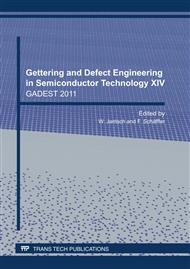p.166
p.172
p.178
p.183
p.188
p.192
p.201
p.205
p.211
Evolution of Oxygen Associated Defects in Cz Silicon during Thermal Annealing Treatments: Comparison between Experiment and Simulation
Abstract:
High temperature annealing effects on Oxygen-induced defects formation has been studied by IR-LST, FTIR and TEM techniques. The results show that most defects are amorphous oxygen precipitates and/or dislocations. Ham’s theory has been modified in order to take into account the variations of interstitial oxygen concentration during the formation of precipitates. Comparison between experimental data and simulation shows that the specificity of annealing cycle is to combine both nucleation and growth stages. The morphology and stoechiometry of SiOx precipitates are also studied.
Info:
Periodical:
Pages:
188-191
Citation:
Online since:
August 2011
Authors:
Price:
Сopyright:
© 2011 Trans Tech Publications Ltd. All Rights Reserved
Share:
Citation:


